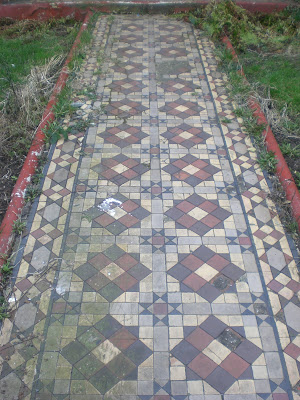It seems to me that most architectural detail tends to relate to the building itself but the path to the front door is often caught between two worlds. It is sometimes called upon to act as a sort of 'proto-hall' and throw its hat in with the building whilst at other times it remains resolutely part of the garden and the natural world and adapts itself fully to that particular role. Think of the differences between the extravagant mosaic or tiled path compared to the gravel drive - the former is basically saying that you're already inside (despite the lack of walls or roof) whilst the latter with its crunching not only reminds you of a beach at low tide - emphasising your sense of 'out-sideness' - but also serves as a warning of your approach. You are very much in the garden world when you walk on gravel.
Of course there's always the middle way that most of us end up with, namely of a bit of concrete, a few slabs from B&Q or a ribbon of tarmac but that seems so fully utilitarian as to be almost devoid of any imaginative spark or interest. Not that a gravel path is much better but it does at least have a sense of life about it somehow as it gets moved about into various banks and drifts, grinds satisfyingly underfoot and can even find itself being picked up and thrown around by small children, giving it a sort of kinetic quality all-round.
The examples that I found down a single road seem mostly to have been created to a specific formula and method, with a tile 'carpet' being laid into a concrete base. Most of the others haven't survived and have either been covered over or torn up, but these ones struggle on showing how difficult it is to maintain that highly desirable 'house coming out to greet you' look over any length of time. Tiles fade, crack, lift in frosts, succumb to subsidence, face an unequal struggle with mould and weeds and generally start to look a bit tatty. Of course that's when Faded London likes them best but really you'd have to admit that their glory days are pretty much behind them at that point.
I don't think it helps that the fine old family houses they serve are now divided up into flats although it could be a double-edged sword. Would a single owner have lifted them in the 70s and put down something more modern, like the neighbours? Or could it be that having an absentee landlord means that they are willing to leave the paths there for as long as possible, even if they're not going to maintain them?
The most successful survivors seem to be the paths based on solid blocks of colour - mini-mosaics that retain the layout and the depth of colour - but the most interesting are those that use tiles with patterns or designs on them. You know there's no chance of finding replacements for those tiles that have given up the ghost and been rubbed bare and once these paths get past a certain point you know it'll only be a matter of time before they're gone for good
So although I'm willing to accept that they may not be the most exciting of objects I do have to admit to finding them quite appealing and more than worthy enough for a brief acknowledgement and a salute before any final appointment with a pick-axe and a small skip.







4 comments:
You're not alone, I have always had a bit of a thing for old, beautiful garden paths.
Very nice set of photos...
Nice post
-------
Hi
I have started a new blog for blog submission and link exchange.
Please submit your blog or url on my blog.
http://blog-linkexchange-blog.blogspot.com/
Interestingly, the post below yours in my newsreader was this one:
http://thetextileblog.blogspot.com/2010/03/owen-jones-and-ornament-of-middle-ages.html
Lots of Victorian tile designs there....
Post a Comment